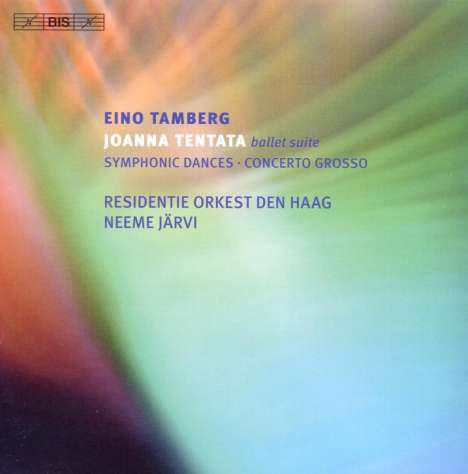Eino Tamberg: Orchesterwerke auf CD
Orchesterwerke
Herkömmliche CD, die mit allen CD-Playern und Computerlaufwerken, aber auch mit den meisten SACD- oder Multiplayern abspielbar ist.
(soweit verfügbar beim Lieferanten)
Joanna Tentata-Ballettsuite op. 37a; Symphonische Tänze op. 6; Concerto grosso op. 5
- Künstler:
- Residentie Orkest Den Haag, Neeme Järvi
- Label:
- BIS
- Aufnahmejahr ca.:
- 2009
- Artikelnummer:
- 3548915
- UPC/EAN:
- 7318590016770
- Erscheinungstermin:
- 23.6.2010
Seit mehr als 50 Jahren ist Eino Tamberg eine der einflussreichsten Persönlichkeiten auf musikalischem Gebiet in seiner Heimat Estland. Sein internationaler Durchbruch kam 1956 mit „Concerto grosso“ op. 5, das die Welle internationalen Interesses an Komponisten wie Arvo Pärt, Veljo Tormis und anderen auslöste. Deutlich wird Tambergs Leidenschaft für Orchesterfarben; sein demonstrativer Einsatz von Saxophonen ein (später) Protest gegen die Stalin-Ära, in der das Instrument als „dekadent“ gebrandmarkt war. Die 1972 entstandene Ballettsuite bezeugt Tambergs Interesse am Theater.
For more than fifty years, Eino Tamberg has remained an influential figure in the musical life of his native Estonia. His breakthrough on the international music scene came in 1956 with Concerto grosso, Op. 5, which also heralded the success of the 'new wave' of Estonian composers, including Arvo Pärt, Veljo Tormis and others. Tamberg's passion for instrumental colours stands out, and manifests itself in the Concerto grosso, with its solo group including flute, clarinet, trumpet, alto saxophone, bassoon and piano; the use of the saxophone is especially notable in view of the fact that in the Stalin era this instrument had been branded as 'decadent'. A year later, Tamberg again included saxophones in a score, namely that of his Symphonic Dances, Op. 6. The work incorporates Estonian folk tunes, although these have been transformed in various ways and are almost completely integrated into the symphonic texture. Even so the work reveals the spontaneous, elementary power of dance. A later work, the Suite from 'Joanna Tentata' from 1972, serves as an example of Tamberg's great interest in the theatre. The plot of the ballet for which the original score was composed picks up more or less where Penderecki's famous opera 'The Devils from Loudun' ends - the story of a French 17th-century convent in which the nuns have become possessed, and of the love between the convent's Mother Superior and a pious young priest. Rather than religion, it is the concept of dogma that interested Tamberg in this story, which he has described as a confrontation between 'a suffering human mind, relying on dogma, and the common people who don't care about any of this and are happy with their own ways.' These three scores are conducted by Tamberg's compatriot and long-time champion Neeme Järvi. Appearing with various orchestras on a large number of BIS releases, he is also chief conductor of the Residentie Orkest Den Haag which here makes its first recording for the label.
Disk 1 von 1 (CD)
Joanna Tentata Suite op. 37a (1972)
-
1 1. The all-possessed nuns
-
2 2. Round dance
-
3 3. Chorale
-
4 4. Prayers and passions
-
5 5. Feasting people
-
6 6. Delusions
-
7 7. Transfiguration: Despair
Sinfonische Tänze op. 6 (1957)
-
8 1. Moderato - Allegro giocoso
-
9 2. Andante sostenuto
-
10 3. Allegro giusto e molto marcato
Concerto grosso op. 5 (1956)
-
11 1. Allegro moderato - Allegro
-
12 2. Adagio
-
13 3. Allegro molto, quasi toccata



